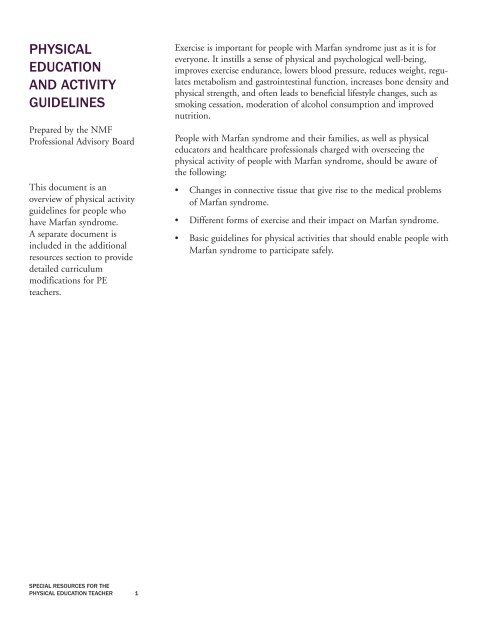Marfan Syndrome:
Marfan Syndrome:
Marfan Syndrome:
Create successful ePaper yourself
Turn your PDF publications into a flip-book with our unique Google optimized e-Paper software.
PHYSICAL<br />
EDUCATION<br />
AND ACTIVITY<br />
GUIDELINES<br />
Prepared by the NMF<br />
Professional Advisory Board<br />
This document is an<br />
overview of physical activity<br />
guidelines for people who<br />
have <strong>Marfan</strong> syndrome.<br />
A separate document is<br />
included in the additional<br />
resources section to provide<br />
detailed curriculum<br />
modifications for PE<br />
teachers.<br />
SPECIAL RESOURCES FOR THE<br />
PHYSICAL EDUCATION TEACHER 1<br />
Exercise is important for people with <strong>Marfan</strong> syndrome just as it is for<br />
everyone. It instills a sense of physical and psychological well-being,<br />
improves exercise endurance, lowers blood pressure, reduces weight, regulates<br />
metabolism and gastrointestinal function, increases bone density and<br />
physical strength, and often leads to beneficial lifestyle changes, such as<br />
smoking cessation, moderation of alcohol consumption and improved<br />
nutrition.<br />
People with <strong>Marfan</strong> syndrome and their families, as well as physical<br />
educators and healthcare professionals charged with overseeing the<br />
physical activity of people with <strong>Marfan</strong> syndrome, should be aware of<br />
the following:<br />
• Changes in connective tissue that give rise to the medical problems<br />
of <strong>Marfan</strong> syndrome.<br />
• Different forms of exercise and their impact on <strong>Marfan</strong> syndrome.<br />
• Basic guidelines for physical activities that should enable people with<br />
<strong>Marfan</strong> syndrome to participate safely.


